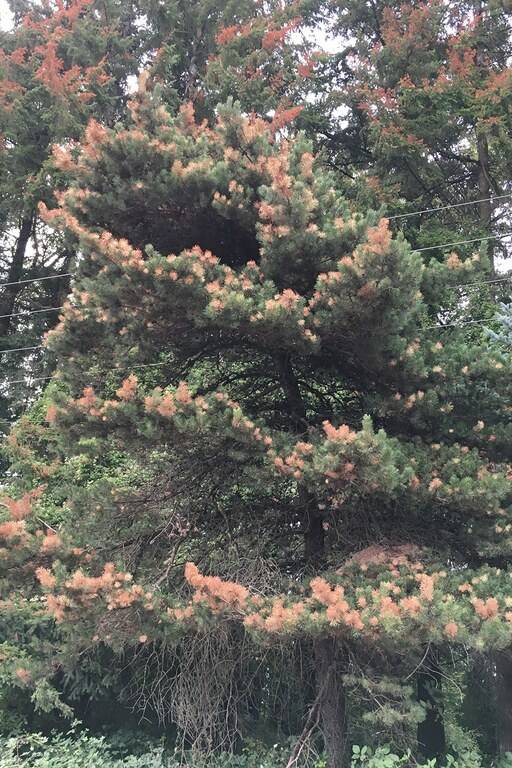In the days after a record-breaking heat wave baked the Pacific Northwest in 2021, state and federal foresters heard reports of damaged and dying trees across Oregon and Washington. Willamette Valley Christmas tree farmers had lost up to 60% of their popular noble firs, while caretakers at Portland’s Hoyt Arboretum said Douglas firs, their state tree, dropped more needles than ever seen before. Timber plantations reported massive losses among their youngest trees, with some losing nearly all of that year’s plantings.
The damage was obvious even to those who weren’t tasked with looking for it. Drivers, homeowners and tree experts alike called or sent photos of damaged redcedars, hemlocks and spruce, particularly in coastal forests. Swaths of the landscape were so scorched it looked like a wildfire had torn through.
Some farmers and homeowners had tried to prepare, dumping water on their orchards and yards before and during the heat wave. Many lost branches, leaves and entire trees anyway. “There’s a misconception out there that a lot of people have that, if things are just watered enough, they can get through these events,” said Chris Still, an Oregon State University tree ecologist and expert in tree heat physiology. “But the heat spells we’re talking about, like the heat dome, are so intense that I don’t think that’s really a tenable assumption anymore.”
Simply watering trees during extreme heat makes intuitive and practical sense, but that idea is based largely on knowledge about droughts. After all, nearly all of the research on climate-related stress in trees has focused only on the impact of insufficient water. But it turns out that trees respond quite differently to extreme heat versus prolonged drought. Still’s own research, including a new study on the heat dome, is part of a growing body of work focused on untangling the effects of both conditions. Given that extreme heat and drought are both becoming more common and intense — and won’t always coincide — foresters and tree farmers will need tools to prepare for each.
The heat spells we’re talking about, like the heat dome, are so intense that I don’t think that’s really a tenable assumption anymore.”
The threat human-caused global warming poses to the Northwest’s forests was evident long before the 2021 heat dome: Oregon and Washington’s most common conifer species are all dying in alarming numbers, many because of drought. Starting in 2015, state foresters began warning that Western hemlocks, a particularly drought-sensitive species common to the Coast Range and Cascades, were succumbing to pests and fungi that infested the already-stressed trees. More recently, foresters have seen widespread die-offs of Western redcedar and Douglas firs. Aerial surveys in 2022 documented what foresters have dubbed “firmageddon” — the sudden death of 1.2 million acres of “true firs” (which include grand and noble firs, but not Douglas firs), mostly in Oregon.
“All of our trees are drought-stressed,” Oregon state entomologist Christine Buhl told HCN last July. “They can’t protect themselves against other agents” in their weakened state. Even common pests and native parasites that don’t normally kill trees are now proving lethal.
When the 2021 heat wave hit, foresters weren’t certain what new chaos it might bring. Drought affects tree stems and the structures that move water and nutrients around, but heat destroys needles and leaves. When those tender green structures heat up — and they often reach temperatures far higher than the air around them — they lose water fast. The tissues inside them fall apart, and they turn red or brown as their chlorophyll breaks down.
“Just like our skin, when (sun exposure) rips those cells apart and we have blisters and sunburn, it does the same exact thing to those needles and leaves,” said Danny DePinte, a forest health specialist who flies annual aerial surveys for the U.S. Forest Service in Washington and Oregon. The 2021 heat dome offered a rare glimpse of the results on a large scale: When DePinte flew over the region later that year, he saw whole landscapes of trees scorched on their south and west-facing sides, where temperatures would have been hottest.
The worst damage occurred on southern slopes with prolonged exposure and in coastal forests that are adapted to far cooler temperatures. DePinte’s survey found that at least 229,000 acres of forest had been damaged by the heat wave — a figure state researchers say only begins to capture the total area damaged, which was likely much larger.
Research like Still’s, which drew in part on DePinte’s data, has made it clear that heat stress causes more immediate and acute damage than drought. Its long-term impacts are far less understood, though, because events like the 2021 heat dome are still unusual.
On his 2022 survey flights, DePinte found that the most obvious damage seems to have been temporary: Damaged areas are mostly green again with new growth. Further research, by Still’s team and others, will investigate possible lingering health effects, including whether the trees become more susceptible to pests, disease and death.
Researchers will also consider how foresters and tree farmers could respond, as extreme heat waves become more common. Adaptations might include planting certain species together to shade more vulnerable trees, determining which native trees are most tolerant to extreme heat, and planting species on farms or after wildfires that are already adapted to hotter conditions farther south.
“We need to be smart about what trees we’re planting so that we have forests in the same places,” DePinte said. “We’ve got to think hundreds of years into the future: What is this area gonna look like? And then plan accordingly.”
This story was produced for High Country News on Feb. 24, 2023 and is republished here with permission.



